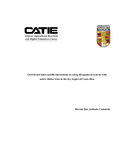Mostrar el registro sencillo del ítem
Growth and inter-specific interations in young silvopastoral systems with native timber trees in the dry tropics of Costa Rica
| dc.contributor.author | Andrade Castañeda, Hernán J. | |
| dc.date.accessioned | 2014-10-17T15:41:42Z | |
| dc.date.available | 2014-10-17T15:41:42Z | |
| dc.date.issued | 2007-03 | es_ES |
| dc.identifier | 372883 | es_ES |
| dc.identifier.uri | https://repositorio.catie.ac.cr/handle/11554/2251 | |
| dc.description | Tesis (Ph. D.) -- CATIE, Turrialba (Costa Rica) -- University of Waler (UWB), Gwynedd (Reino Unido), 2007 | es_ES |
| dc.description.abstract | El objetivo central de este estudio fue entender las principales interacciones en sistemas silvopastoriles en el trópico seco. El crecimiento de árboles, la Producción de pasto, la interacción de raíces finas, la competencia por agua y radiación fueron estudiados para evaluar las más importantes interacciones biofísicas en el trópico seco. Los sistemas silvopastoriles evaluados mostraron grandes beneficios productivos y ambientales tal como la promoción del crecimiento de árboles a través del establecimiento de especies de pastos productivas y tolerantes a la sequía la Producción de materia seca de los pastos no fue afectada por los árboles después de cuatro años un relativo alto secuestro de carbono en biomasa y suelo fijación de nitrógeno de las especies arbóreas diferenciación de nicho en términos de exploración de suelo y la adaptación de las especies evaluadas a ambientes estacionalmente secos. La investigación futura sobre sistemas silvopastoriles in el trópico seco debería estar enfocada en la evaluación de prácticas de manejo para reducir la competencia árbolpastura y mejorar la calidad de la madera. Similarmente, es necesario dirigir más atención en la estimación de evapotranspiración en pasturas, lo cual es el principal componente de uso de agua en estos sistemas, y sobre disponibilidad de fósforo debido a que se conoció el potencial de estas especies arbóreas nativas en el mejoramiento del contenido de nitrógeno del suelo. The central aim of this study was to understand the main tree-grass interactions in silvopastoral systeMON in the dry tropics. Tree growth, grass production, fine root interactions, water and radiation competition were studied to evaluate the most important biophysical interactions in dry tropics. The silvopastoral systeMON evaluated showed great productive and environmental benefits such as the promotion of tree growth through the establishment of drought tolerant and productive grass species the dry matter production of grass species was not affected by trees after four years a relative high carbon sequestration in biomass and soil nitrogen fixing of tree timber species niche differentiation in terMON of soil exploration and the adaptation of evaluated species to seasonally dry environments. The future research on silvopastoral systeMON in the dry tropics should be focussed on the evaluation of management practice to reduce tree-grass competition and to improve timber quality. Similarly, more attention needs to be directed to the estimation of the evapotranspiration of grasses, which is the main componente of the water use in these silvopastoral systeMON, and about phosphorus interactions because it was know the potential of these tree native species to improve soil nitrogen. | es_ES |
| dc.subject | TROPICOS SECOS | |
| dc.subject | ALBIZIA SAMAN | |
| dc.subject | DALBERGIA RETUSA | |
| dc.subject | BRACHIARIA BRIZANTHA | |
| dc.subject | HYPARRHENIA RUFA | |
| dc.subject | ARBOLES MADERABLES | |
| dc.subject | ESPECIES NATIVAS | |
| dc.subject | SISTEMAS SILVOPASCICOLAS | |
| dc.subject | PRODUCTIVIDAD | |
| dc.subject | SOSTENIBILIDAD | |
| dc.subject | BIOMASA | |
| dc.subject | ECUACIONES ALOMETRICAS | |
| dc.subject | RESISTENCIA A LA SEQUIA | |
| dc.subject | PROPIEDADES FISICOQUIMICAS | |
| dc.subject | SUELO | |
| dc.subject | BALANCE HIDRICO DEL SUELO | |
| dc.subject | AGROFORESTERIA | |
| dc.title | Growth and inter-specific interations in young silvopastoral systems with native timber trees in the dry tropics of Costa Rica | es_ES |
| dc.type | Tesis de maestría | es_ES |
Ficheros en el ítem
Este ítem aparece en la(s) siguiente(s) colección(ones)
-
Tesis [1728]


